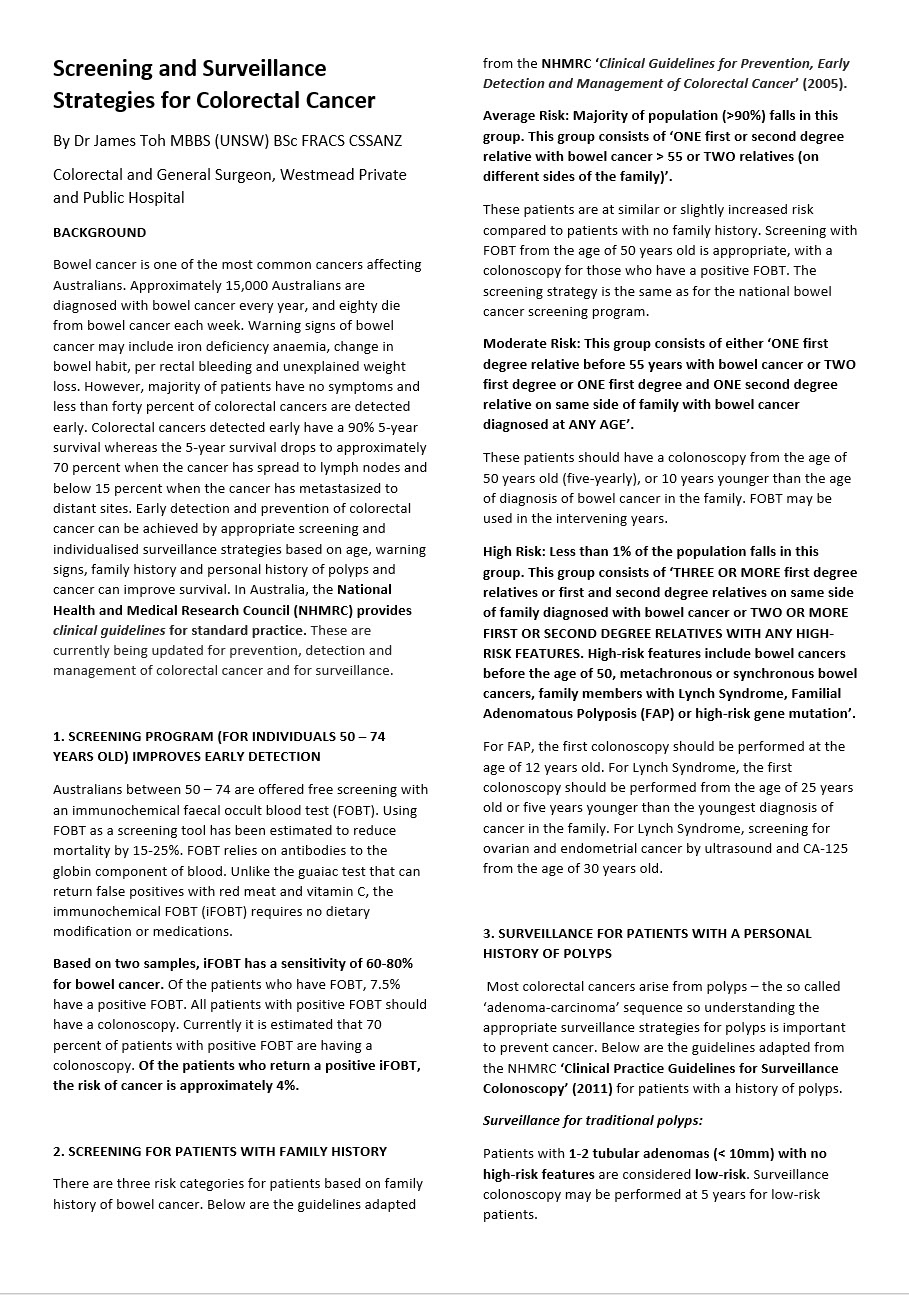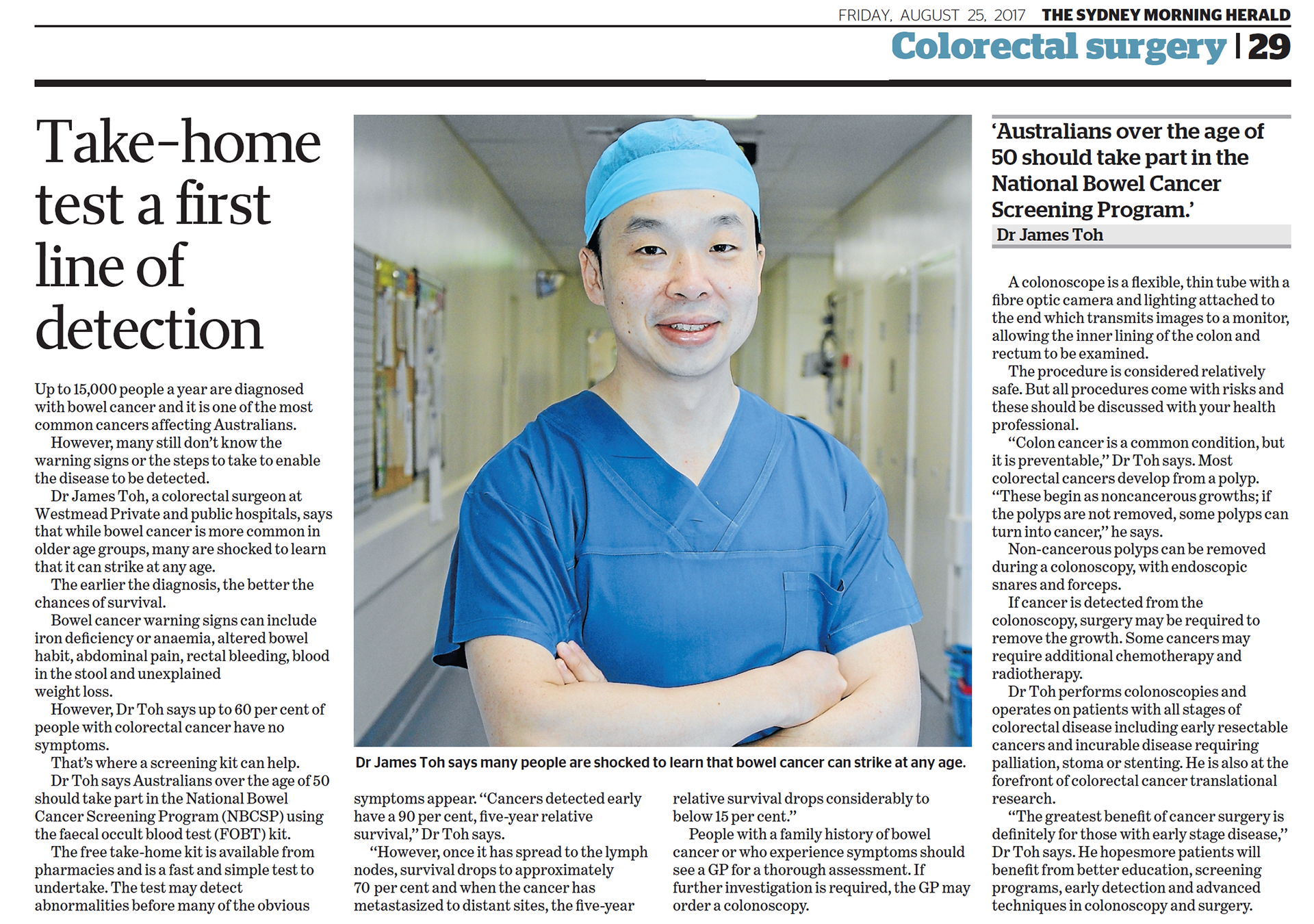BACKGROUND
• Bowel cancer is one of the most common cancers affecting Australians. Approximately 15,000 Australians are diagnosed with bowel cancer every year, and eighty die from bowel cancer each week. Warning signs of bowel cancer may include iron deficiency anaemia, change in bowel habit, per rectal bleeding and unexplained weight loss. However, majority of patients have no symptoms and less than forty percent of colorectal cancers are detected early.
• Colorectal cancers detected early have a 90% 5-year survival whereas the 5-year survival drops to approximately 70 percent when the cancer has spread to lymph nodes and below 15 percent when the cancer has metastasized to distant sites.
• Early detection and prevention of colorectal cancer can be achieved by appropriate screening and individualised surveillance strategies based on age, warning signs, family history and personal history of polyps and cancer can improve survival. In Australia, the National Health and Medical Research Council (NHMRC) provides clinical guidelines for standard practice. These are currently being updated for prevention, detection and management of colorectal cancer and for surveillance.
1. SCREENING PROGRAM (FOR INDIVIDUALS 50 – 74 YEARS OLD) IMPROVES EARLY DETECTION
• Australians between 45 – 74 are offered free screening with an immunochemical faecal occult blood test (FOBT). Using FOBT as a screening tool has been estimated to reduce mortality by 15-25%. FOBT relies on antibodies to the globin component of blood. Unlike the guaiac test that can return false positives with red meat and vitamin C, the immunochemical FOBT (iFOBT) requires no dietary modification or medications.
• Based on two samples, iFOBT has a sensitivity of 60-80% for bowel cancer. Of the patients who have FOBT, 7.5% have a positive FOBT. All patients with positive FOBT should have a colonoscopy. Currently it is estimated that 70 percent of patients with positive FOBT are having a colonoscopy. Of the patients who return a positive iFOBT, the risk of cancer is approximately 4%.
2. SCREENING FOR PATIENTS WITH FAMILY HISTORY
• There are three risk categories for patients based on family history of bowel cancer. Below are the guidelines adapted from the NHMRC ‘Clinical Guidelines for Prevention, Early Detection and Management of Colorectal Cancer’ (2005).
• Average Risk: Majority of population (>90%) falls in this group. This group consists of ‘ONE first or second degree relative with bowel cancer > 55 or TWO relatives (on different sides of the family)’.
• These patients are at similar or slightly increased risk compared to patients with no family history. Screening with FOBT from the age of 50 years old is appropriate, with a colonoscopy for those who have a positive FOBT. The screening strategy is the same as for the national bowel cancer screening program.
• Moderate Risk: This group consists of either ‘ONE first degree relative before 55 years with bowel cancer or TWO first degree or ONE first degree and ONE second degree relative on same side of family with bowel cancer diagnosed at ANY AGE’.
• These patients should have a colonoscopy from the age of 50 years old (five-yearly), or 10 years younger than the age of diagnosis of bowel cancer in the family. FOBT may be used in the intervening years.
• High Risk: Less than 1% of the population falls in this group. This group consists of ‘THREE OR MORE first degree relatives or first and second degree relatives on same side of family diagnosed with bowel cancer or TWO OR MORE FIRST OR SECOND DEGREE RELATIVES WITH ANY HIGH-RISK FEATURES. High-risk features include bowel cancers before the age of 50, metachronous or synchronous bowel cancers, family members with Lynch Syndrome, Familial Adenomatous Polyposis (FAP) or high-risk gene mutation’.
• For FAP, the first colonoscopy should be performed at the age of 12 years old. For Lynch Syndrome, the first colonoscopy should be performed from the age of 25 years old or five years younger than the youngest diagnosis of cancer in the family. For Lynch Syndrome, screening for ovarian and endometrial cancer by ultrasound and CA-125 from the age of 30 years old.
3. SURVEILLANCE FOR PATIENTS WITH A PERSONAL HISTORY OF POLYPS
• Most colorectal cancers arise from polyps – the so called ‘adenoma-carcinoma’ sequence so understanding the appropriate surveillance strategies for polyps is important to prevent cancer. Below are the guidelines adapted from the NHMRC ‘Clinical Practice Guidelines for Surveillance Colonoscopy’ (2011) for patients with a history of polyps.
• Surveillance for traditional polyps:
• Patients with 1-2 tubular adenomas (< 10mm) with no high-risk features are considered low-risk. Surveillance colonoscopy may be performed at 5 years for low-risk patients.
• Patients with 3 or more adenomas or adenomas >/= 10mm or adenomas with tubulo-villous or villous histology or high grade dysplasia are considered high-risk and should have a colonoscopy at 3 years.
• Patients with greater than 5 polyps should have a yearly colonoscopy. If > 10 polyps, consider polyposis syndromes. For incomplete / piecemeal excision, a colonoscopy should be performed at 3-6 months.
• Surveillance for hyperplastic polyps:
• For hyperplastic polyps, surveillance depends on size and location, not number of lesions. • For rectosigmoid hyperplastic polyps < 5mm, this is considered low-risk. If there are any hyperplastic polyps proximal to sigmoid or if rectosigmoid hyperplastic polyps 5-9mm, then surveillance colonoscopy should be performed earlier as these are considered higher risk. For traditional or sessile serrated adenomas, the surveillance strategy should be as for adenomas. For hyperplastic polyposis, colonoscopy should be offered biennially. Risk of cancer associated with hyperplastic polyps is still not well known.
4. SURVEILLANCE FOR PATIENTS WITH A PERSONAL HISTORY OF COLORECTAL CANCER
• Recurrence post curative resection for colorectal cancer is approximately 35%. 90% of recurrence occurs within 5 years. If a colonoscopy was not performed prior to resection, then a colonoscopy should be performed within 3-6 months of surgery. If a colonoscopy was performed prior to surgery, then the next colonoscopy should be performed at 1 year.
• If this colonoscopy is normal, then the next colonoscopy should be performed in 5 years. If polyps are detected, then follow the surveillance strategy for polyps (see above). Patients post curative resection for colon cancer should have 3-6 monthly visits with the specialist surgeon for 2 years, then 6-monthly until 5 years, with carcinoembryonic antigen (CEA) and computed tomography (CT) scans recommended as part of the surveillance strategy. Patients post curative rectal cancer resection should have 3-6 monthly assessments with the specialist surgeon for 2 years with digital rectal examination and proctoscopy or flexible sigmoidoscopy, then 6 monthly assessments until 5 years.
ADVANCED TECHNIQUES IN POLYP AND CANCER DETECTION
• There are several advanced techniques in colonoscopy which may improve adenoma and cancer detection rate. These include water assisted colonoscopy, high definition white light endoscopy (may improve polyp detection by up to 3.5%), cap assisted colonoscopy, third eye retroscope – normal scope view and an additional image at 180 degrees to the scope view (may increase adenoma detection rate by up to 15%), dye spray chromoendoscopy (may improve detection of dysplasia by up to 30%), virtual chromoendoscopy narrow band imaging and intelligent chromoendoscopy, narrow band imaging (consists of optical filters where narrow band light from 415-540nm passes between a xenon arc lamp and red/green/blue rotation filter) – this illuminates vascular-rich polyps as haemoglobin absorption band most effective at 415nm and thick vessels at 540nm, I-Scan highlights vessels and pit patterns and real time Kudo Pit Pattern analysis which predicts histopathology before excision to ensure real-time decisions can be made while performing colonoscopy.
• These practice guideline strategies and advanced techniques in polyp and cancer detection have been shown to improve early detection and survival rates from colorectal cancer.
References:
National Health and Medical Research Council (NHMRC) ‘Clinical Guidelines for Prevention, Early Detection and Management of Colorectal Cancer’ (2005) https://www.nhmrc.gov.au/guidelines-publications
National Health and Medical Research Council (NHMRC) ‘Clinical Practice Guidelines for Surveillance Colonoscopy’ (2011) https://www.nhmrc.gov.au/guidelines-publications


